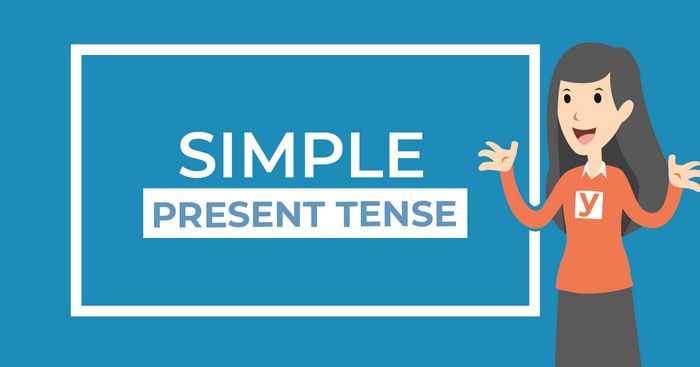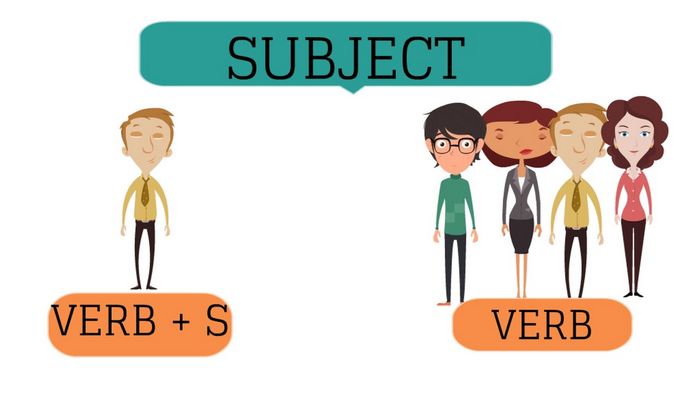Pada materi simple present tense ini sobat akan mempelajari jenis & rumus simple present tense, contoh kalimat, cara pembentukan kalimat positif, negatif & interogatif (kalimat tanya), cara menambahkan S & ES dan juga latihan soal untuk mengasah pengetahuan sobat semua tentang simple present tense.

Apa Itu Simple Present Tense?
Simple Present Tense tak sesimple seperti namanya. Orang barat memakai simple present tense untuk membicarakan berbagai hal yang berbeda dengan cara yang berbeda.
Di Indonesia, kita hanya mengetahui fungsi pemakaian simple present tense secara umumnya saja. Jika ingin di gali lebih dalam, hampir semua percakapan sehari-hari orang Inggris menggunakan simple present tense.
Misalnya:
Untuk membicarakan hal yang disukai, mendeskripsikan sesuatu, menyatakan kemampuan, meminta dan menawarkan sesuatu, menyatakan kepunyaan dan masih banyak lagi.
Tapi, pada materi ini kita tidak akan membahas semual hal di atas. Biar lebih fokus, kita akan bahas simple present tense lebih dalam di artikel terpisah. Tentunya, setelah sobat memahami penggunaan umum simple present tense.
Pelajari Juga:
Fungsi Simple Present Tense
Secara umum fungsi simple present tense yaitu digunakan untuk menjelaskan suatu perbuatan atau peristiwa yang kita kerjakan atau terjadi sehari–hari (kebiasaan umum).
Jenis Simple Present Tense
Jenis kalimat simple present tense terbagi menjadi dua yaitu kalimat verbal (Do & Does) dan kalimat nominal (am, is & are).
1. Simple Present Tense (Verbal)
Kalimat verbal adalah kalimat yang mengandung suatu tindakan atau perbuatan.
Contoh Kalimat: I wake up at 4 a.m every morning, They go to school everyday, She plays piano once a week, etc.
2. Simple Present Tense (Nominal)
Sedangkan kalimat nominal adalah kalimat yang tidak mengandung suatu tindakan atau perbuatan.
Contoh Kalimat: She is a civil servant, They are students, We are at school, You are handsome, etc.
Contoh kalimat simple present tense diatas hanyalah sebagai perkenalan sebelum masuk ke materi yang lebih detail.
Yuk, kita mulai materi pelajaran simple present tense mulai dari kalimat verbal terlebih dahulu.

1. Simple Present Tense (Verbal)
Seperti yang sudah kita jelaskan di atas, secara umum simple present tense dipakai untuk menyatakan suatu kegiatan sehari-hari, kebiasaan dan juga menjelaskan suatu fakta yang tak terbantahkan.
Terus, bagaimana membuat kalimat simple present tense?
Rumus Simple Present Tense (Verbal)
Dibawah ini Kincet.com sajikan aturan pembentukan kalimat simple present tense dalam bentuk positif, negatif dan interogatif (tanya).
A. Rumus Dalam Bentuk Kalimat Positif (+)
Dalam membuat suatu kalimat simple present tense dalam bentuk positif, kita menggunakan V1 yang di letakkan setelah subjek dan biasanya di ikuti dengan keterangan waktu (tidak wajib).
| Subject | V1 + S/ES | Object | Adverb of Time |
| I | go | to school | every morning |
| You | come | to my house | every Sunday |
| We | drink | milk | everyday |
| They | eat | rice | twice a day |
| He | speaks | English | every time |
| She | watches | television | every night |
| It (The Cat) | steals | fish | today |
| Father | goes | to office | everyday |
| Mother | cooks | rice | once a day |
| You & I | study | Spanish | three times in a week |
Keterangan:
Subject They, We, I & You, baca (DEWI AYU) menggunakan V1 tanpa penambahan S/ES didalam kata kerja.
Sedangkan
Subject He, She, It, Father & Mother atau yang sering kita sebut orang ketiga tunggal menggunakan penambahan S/ES pada kata kerja V1. Perhatikan tulisan yang Kincet.com kasih warna merah pada table diatas.
Perhatikan: Penambahan S/ES pada kata kerja hanya untuk orang ketiga tunggal (Singular form).
Cara Penambahan S & ES pada Verb-1
Cara menambahkan huruf S/ES pada kerja pertama adalah sebagai berikut:
1. Apabila kata kerja pertama tersebut berakhiran dengan huruf : ch, sh, x,ss, o, z maka kita harus menambahkan huruf ES.
Contoh:
| Watch | Watches | Menonton |
| Teach | Teaches | Mengajar |
| Catch | Catches | Menangkap |
| Push | Pushes | Mendorong |
| Wash | Washes | Mencuci |
| Finish | Finishes | Menyelesaikan |
| Box | Boxes | Meninju |
| Fix | Fixes | Memperbaiki |
| Mix | Mixes | Mengaduk, mencampur |
| Kiss | Kisses | Mencium |
| Miss | Misses | Merindukan, kehilangan, kangen |
| Pass | Passes | Lewat, melewati, lulus |
| Do | Does | Mengerjakan |
| Go | Goes | Pergi |
| Quiz | Quizes | Menguji |
2. Apabila kata kerja pertama ( verb 1 ) tersebut berakhiran dengan huruf “ Y “ dan didahului oleh huruf mati maka huruf “ Y “ tersebut harus kita ganti menjadi huruf “ I ”, lalu kita tambahkan huruf “ ES “
Contoh:
| Study | Studies | Belajar |
| Cry | Cries | Menangis |
| Dry | Dries | Mengeringkan, Menjemur |
| Try | Tries | Mencoba |
| Carry | Carries | Membawa |
| Fry | Fries | Megoreng |
| Fly | Flies | Terbang |
Perlu diingat apabila kata kerja pertama (Verb 1) tersebut berakiran dengan huruf “ Y “ dan didahului oleh huruf hidup (a, i, u, e, o), maka kita hanya menambahkan huruf “S“ saja.
Contoh:
| Play | Plays | Bermain, Memainkan |
| Buy | Buys | Membeli |
| Pay | Pays | Membayar |
3. Selain dari ketentuan tersebut diatas kita cukup menambahkan huruf “S“ saja pada kata kerja pertamanya, apabila subyeknya orang ketiga tunggal (He, She, It)

Contoh Kalimat Simple Present Tense Dalam Bentuk Positif
- I fish in the river once a week.
- You visit Yogya every school holiday.
- We play game every weekend.
- They run in the park every morning.
- He exercises at the gym every afternoon.
- She writes a letter to uncle John once a month.
- My dog barks every morning.
- My mother goes to traditional market twice a week.
- My father reads newspaper every morning.
- Yolanda, Nina & Rini play piano every weekend.
Catatan Tambahan
Keterangan waktu yang biasa digunakan pada SIMPLE PRESENT TENSE adalah:
- Every…. : setiap…..
- Everyday: setiap hari
- Every night: setiap malam
- Every week: setiap minggu
- Every month: setiap bulan
- Every year: setiap tahun
- Every Sunday: setiap hari minggu
- Today: hari ini
- Once a day: sekali sehari
- Once a week: sekali seminggu
- Twice a month: dua kali sebulan
- Thrice/ three times a year: tiga kali setahun
- In the morning: dipagi hari
- At night: dimalam hari
- In the afternoon: disore hari
- On Sunday: pada hari minggu
Apabila ada kata-kata seperti :
- Often: sering
- Always: selalu
- Ever: pernah
- Never: tidak pernah
- Usually: biasanya
- Sometimes: kadang-kadang
- Seldom: jarang
Maka kita letakkan kata tersebut sebelum kata kerja (Verb).
Contoh :
I always go to school at seven o’clock a.m.
She often buys some food in school canteen.
We seldom play basket ball.
BACA JUGA:
- Contoh Cerpen Bahasa Inggris & Artinya
- 50+ Puisi Bahasa Inggris & Artinya
- 30 Contoh Dialog Bahasa Inggris 2 Orang Beserta Artinya
- 50+ Contoh Percakapan Bahasa Inggris & Artinya [Tema Lengkap]
B. Rumus Dalam Bentuk Kalimat Negatif (-)
Jika tadi diatas kita sudah belajar bagaimana membentuk kalimat simple present tense dalam bentuk positif, sekarang kita akan belajar bagaimana merubah kalimat positif tersebut ke dalam bentuk negatif.
Untuk membuat kalimat negatif, kita cukup menambahkan DO/DOES + Not setelah subject dan menghilangkan penambahan S/ES pada kata kerja orang ketiga tunggal (He, She & It).
Yuk, kita lihat rumus & contoh kalimat di bawah ini.
| Subject | Do Not / Does Not | Verb-1 | Object | Adverb of Time |
| I | do not | go | to school | every morning |
| You | do not | come | to my house | every Sunday |
| We | do not | drink | milk | everyday |
| They | do not | eat | rice | twice a day |
| He | does not | speak | English | every time |
| She | does not | watch | Television | every night |
| It (The Cat) | does not | steal | fish | today |
| Father | does not | go | to office | everyday |
| Mother | does not | cook | rice | once a day |
| You & I | do not | study | Spanish | three times in a week |
Kenapa Verb-1 untuk ketiga orang tunggal tanpa tambahan S/ES?
Karena pada kalimat negatif, penambahan S/Es pada kata kerja untuk orang ketika tunggal sudah ditambahkan ke kata kerja bantu Do menjadi Does.
Contoh Kalimat Simple Present Tense Dalam Bentuk Negatif
- I don’t need a dictionary.
- You don’t always take a shower every afternoon.
- We don’t know you.
- They don’t teach me English.
- He doesn’t always go to the office.
- She doesn’t visit me everyday.
- This flower doesn’t always bloom every morning.
- You & I don’t go to the gym every afternoon.
- My father doesn’t read newspaper every morning.
- My mother doesn’t like a banana.
C. Rumus Dalam Bentuk Kalimat Tanya (?)
Bagaimana? Sampai sini sudah faham cara merubah kalimat positif ke negatif?
Jika, iya! yuk kita lanjut bagaimana merubah kalimat tersebut diatas ke dalam kalimat tanya.
Untuk merubah kalimat positif ke introgatif (kalimat tanya), kita hanya butuh meletakkan “Do/Does” sebelum subject dan di akhiri dengan tanda (?) pada akhir kalimat.
Untuk lebih detailnya, yuk kita lihat rumus & contoh kalimat di bawah ini.
| Do/Does | Subject | Verb-1 | Object | Adverb of Time |
| Do | I | go | to school | every morning? |
| Do | You | come | to my house | every Sunday? |
| Do | We | drink | milk | Everyday? |
| Do | They | eat | rice | twice a day? |
| Does | He | speak | English | every time? |
| Does | She | watch | Television | every night? |
| Does | It (The Cat) | steal | fish | today? |
| Does | Father | go | to office | everyday? |
| Does | Mother | cook | rice | once a day? |
| Do | You & I | study | Spanish | three times in a week? |
Nah, untuk menjawab pertanyaan diatas, kita gunakan kembali rumus positif untuk jawaban positif dan rumus negatif untuk jawaban negatif. Jangan lupa tambahkan Yes atau No dalam menjawab pertanyaan tersebut.
Yuk, kita lihat jawaban dari kalimat tanya di atas.
Cara Menjawab Pertanyaan “Yes & No Answer” Present Tense
| Jawaban Singkat | Jawaban Lengkap |
| Yes, You do. | Yes, You go to school every morning. |
| No, You don’t. | No, you don’t go to school every morning. |
| Yes, I do. | Yes, I come to your house every Sunday. |
| No, I don’t | No, I don’t come to your house every Sunday. |
| Yes, We do. | Yes, we drink milk everyday. |
| No, we don’t. | No, we don’t drink milk everyday. |
| Yes, they do. | Yes, they eat rice twice a day. |
| No, they don’t | No, they don’t eat rice twice a day. |
| Yes, he does. | Yes, he speaks English every time. |
| No, he doesn’t. | No, he doesn’t speak English every time. |
| Yes, she does. | Yes, she watches Television every night. |
| No, she doesn’t. | No, she doesn’t watch Television every night. |
| Yes, The cat does. | Yes, The cat steals fish today. |
| No, The cat doesn’t. | No, The cat doesn’t steal fish today. |
| Yes, father does. | Yes, father goes to office everyday. |
| No, father doesn’t | No, father don’t go to office everyday. |
| Yes, mother does. | Yes, mother cooks rice once a day. |
| No, mother doesn’t. | No, mother doesn’t cook rice once a day. |
| Yes, we do. | Yes, we study Spanish three times in a week. |
| No, we don’t. | No, we don’t study Spanish three times in a week. |
Kalimat Tanya Simple Present Tense Menggunakan Question Words
Jika tadi kita sudah belajar membuat kalimat pertanyaan dalam bentuk yang sederhana, sekarang Kincet.com mengajak pembaca untuk mengembangkan pertanyaan tersebut dengan “Question Words“.
Question words biasanya digunakan untuk menggali informasi lebih dalam dari orang yang kita ajak bicara.
Untuk membuat pertanyaan seperti ini, kita cukup meletakkan “Question Words” (kata tanya) di awal kalimat sebelum DO & DOES.
Sebelum kita melihat contoh pertanyaannya, ada baiknya sobat mengenal terlebih dahulu apa itu “Question Words” dan apa fungsinya.
| Question Words | Kegunaan |
| What | Apa (Untuk menanyakan benda) |
| Where | Dimana / Kemana (Untuk menanyakan tempat) |
| How | Bagaimana / Naik apa (Untuk menanyakan cara) |
| Why | Mengapa (Untuk menanyakan alasan) |
| When | Kapan (Untuk menanyakan waktu) |
| Who | Siapa (Untuk menanyakan orang sebagai subyek) |
| Whom | Siapa (Untuk menanyakan orang sebagai obyek) |
| With Whom | Dengan siapa (Untuk menanyakan teman. |
Dan masih banyak lagi jenis kata tanya yang bisa dikembangkan seperti :
What time ( jam berapa), what food (makanan apa), what sport (olahraga apa), dll.
How far (berapa jauh), How long (berapa lama/panjang), How many times ( Berapa kali), dll.
Contoh Kalimat Simple Present Tense Dengan Menggunakan Kata Tanya (Question Words).
| Question | Answer |
| What do you eat everyday? | I eat rice everyday. |
| Where does she go today? | She goes to market today. |
| How do they come here? | They come here by motorcycle. |
| Why does he meet you today? | Because he wants to borrow my car. |
| When do we eat rice? | We eat rice everyday. |
| Whom do you wait at home today? | I wait Ani at home today. |
| With whom do you live? | I live with my parents. |
Catatan :
Perlu diingat untuk kata tanya” WHO” pada simple present tense, kita tidak menggunakan DO atau DOES, melainkan langsung ke kata kerjanya.
Contoh :
Question: Who teaches you English everyday?
Answer: Miss, Yeti teaches me English everyday
Question: Who comes here today?
Answer: John comes here today
Question: Who meet us every holiday?
Answer: John and Jack meet us every holiday

Fungsi Lain Dari Simple Present Tense
Selain untuk menjelaskan suatu kegiatan atau kebiasaan rutin dan juga fakta yang tak terbantahkan, Simple Present Tense juga bisa digunakan untuk:
1. Menyatakan Kepunyaan
Untuk menyatakan kepunyaan, kita menggunakan HAVE & HAS pada kalimat Simple Present Tense.
HAVE untuk subject I, They, We & You
Has untuk subject He, She & It.
Contoh Kalimat Simple Present Tense Menggunakan HAVE & HAS
Kalimat Positif (+):
Untuk kalimat positif, kita hanya menambahakn HAVE & HAS setelah subject. Lihat contoh di bawah ini.
| I have a book. | She has a new bag. |
| You have some money. | He has a good car. |
| They have a lot of friends. | The tiger has four legs. |
| We have two houses. | Ani has a ruler. |
Kalimat Negatif (-):
Sedangkan untuk kalimat negatif, kita memakai rumus seperti sebelumnya yaitu menambahkan don’t & doesn’t setelah subject.
| I don’t have a book. | She doesn’t have a new bag. |
| You don’t have some money. | He doesn’t have a good car. |
| They don’t have a lot of friends. | The tiger doesn’t have four legs. |
| We don’t have two houses. | Ani doesn’t have a ruler. |
Kalimat Interogatif (?):
Untuk mengubah kalimat positif ke interogatif, kita hanya meletakkan DO & DOES di awal kalimat.
| Do I have a book? | Does she have a new bag? |
| Do you have some money? | Does he have a good car? |
| Do they have a lot of friends? | Does the tiger have four legs? |
| Do we have two houses? | Does any have a ruler? |
Kesimpulan:
HAS hanya berlaku untuk subyek orang ketiga tunggal ( He, She, It ) dalam kalimat positive (+) saja, apabila kalimat dirubah menjadi kalimat Negative (-) dan Interrogative (?), maka kata kerjanya menjadi HAVE untuk semua subyek.
Contoh Have & Has dengan kata tanya (Question Words)
A : How many brothers and sisters do you have?
B : I have one brother and two sisters.
A : How many teachers does she have at school?
B : She has fifty teachers at school.
A : How many uncles do they have?
B : They have four uncles.
A : How much money does he have?
B : He has five hundred thousands rupiah.
A : What do they have in their bags?
B : They have books, pens, rulers in their bags.
2. Untuk Menyatakan Kemampuan (Ability)
Seperti yang Kincet.com singgung sebelumnya, simple present tense itu tak sesimple namanya 🙂
Untuk menyatakan kemampuan, kita tidak menggunakan kata kerja bantu DO/DOES untuk membentuk kalimat negatif dan interogatif karena CAN sudah termasuk kata kerja bantu.
Contoh Kalimat Simple Present Tense Menggunakan “CAN”
| Kalimat Positif (+) | Kalimat Negatif (-) | Kalimat Interogatif (?) |
| I can swim. | I cannot swim | Can I swim? |
| You can play football. | You cannot play football. | Can you play football? |
| She can cook Pasta | She cannot cook pasta. | Can she cook pasta? |
| He can play a guitar. | He cannot play guitar. | Can he play guitar? |
| Dina can speak English. | Dina cannot speak English. | Can Dina speak English? |
Kesimpulan:
Untuk pembentukan kalimat negatif, kita cukup menambahkan NOT setelah CAN.
Untuk pembentukan kalimat interogatif, kita letakkan CAN di awal kalimat.
Dan untuk menjawab YES & No question kita cukup menambahkan CAN atau CANNOT setelah subject.
Contoh: Yes, I Can. No, I cannot. Yes, she can. No, she cannot.

Contoh Soal Simple Present Tense
Untuk mengasah kemampuan sobat dalam belajar simple present tense, berikut Kincet.com berikan contoh-contoh soal simple present tense untuk latihan dirumah.
Soal Essay
Terjemahkanlah kalimat-kalimat berikut ini kedalam Bahasa Inggris.
- Berapa kali kamu makan dalam sehari?
- Dia (lk) membeli mobil setiap tahun.
- Saya tidak menelpon mu hari ini.
- Apakah mereka bermain badminton setiap sore?
- Siapa masak didapur hari ini?
- Orang tua saya tidak mengirimi saya uang setiap bulan.
- Berapa kosa kata kamu menghapal dalam sehari?
- Dia (pr) memberi saya roti hari ini.
- Jam berapa kamu biasanya tidur setiap malam?
- Dia (pr) tidak menyapu lantai hari ini.
Soal Multiple Choice
Pilihlah jawaban yang benar A , B, C atau D.
1. What does she do today?
She ….her bedroom today.
a. Clean
b. to clean
c. cleans
d. cleaning
2. How many brothers and sisters do you have?
I….two brothers and three sisters.
a. Have
b. has
c. had
d. to have
3. ….he live with his parents?
Yes, he …. with his parents
a. Does – live
b. does – lives
c. do – live
d. do – lives
4. Where ….she go every morning?
She goes to the office every morning
a. Do
b. did
c. does
d. has
5. Your younger brother…..the birds today
a. Catch
b. catches
c. to catch
d. catching
6. Do you really….my home?
a. Knew
b. knows
c. know
d. known
7. What does he ……about your English ?
a. Thinks
b. think
c. thinking
d. to think
8. How long does it take to the mountain?
It ….about two hours from here.
a. Taken
b. took
c. takes
d. take
9. What….we usually…..for breakfast?
We usually have fried rice with egg, milk and coffee.
a. Do – have
b. do – has
c. does – have
d. does – has
10. I ……not so far from the train station.
a. Lives
b. live
c. living
d. to live
Menyusun Kalimat
Susunlah kata-kata berikut menjadi kalimat yang benar.
- fries – morning – rice – she – every.
- don’t – to party – today – come – we .
- seldom – he – coffee – in the morning – drinks.
- everyday – speak – do – English – you ?
- watch – they – every night – television .
- clothes – wash – doesn’t – today – mother .
- buy – shoes – where – every year – she – does ?
- plays – Anita – never – on Sunday – piano .
- you – today – what – teach – do ?
- study – does – with whom – English – she ?

2. Simple Present Tense (Nominal)
Apabila dalam simple present tense tidak terdapat kata kerjanya, maka kita harus menggunakan To be “am, is, are” yang mengandung arti : ada, adalah, berada.
Nah, To Be (am, is & are) ini merupakan kata kerja bantu untuk menunjukan keberadaan suatu entitas seperti orang, objek dan hal yang abstrak.
Misalnya:
She is a teacher (menunjukan orang), I’m in the class (menunjukan objek) & He is sad now (menunjukan sesuatu yang abstrak.
Rumus Simple Present Tense (Nominal)
Sebelum kita masuk ke rumus simple present tense (am, is & are), akan lebih baik jika kita mengenal dahulu pasangan antara subjek & to be.
Am => I
Are => You, We & They
Is => He, She & It
A. Rumus Kalimat Positif (+)
| Subject | To Be | Adjective, Noun, Adverb | Adverb of time |
| I | am | a student | now |
| You | are | a teacher | |
| We | are | at home | every night |
| They | are | in the office | every morning |
| He | is | happy | today |
| She | is | sad | now |
| It | is | a book |
B. Rumus Kalimat Negatif (-)
| Subject | To Be | Not | Adjective, Noun, Adverb | Adverb of time |
| I | am | not | a student | now |
| You | are | not | a teacher | |
| We | are | not | at home | every night |
| They | are | not | in the office | every morning |
| He | is | not | happy | today |
| She | is | not | sad | now |
| It | is | not | a book |
C. Rumus Kalimat Interogatif (?)
| To Be | Subject | Adjective, Noun, Adverb | Adverb of time |
| Am | I | a student | now? |
| Are | you | a teacher? | |
| Are | we | at home | every night? |
| Are | they | in the office | every morning? |
| Is | he | happy | today? |
| Is | she | sad | now? |
| Is | it | a book? |
D. Yes & No Answer
| Jawaban Singkat | Jawaban Panjang |
| Yes, you are. | Yes, you are a student now. |
| No, you are not. | No, you aren’t a student now. |
| Yes, I am. | Yes, I am a teacher. |
| No, I am not. | No, I am not a teacher. |
| Yes, we are. | Yes, we are at home every night. |
| No, we are not. | No, we aren’t at home every night. |
| Yes, they are. | Yes, they are in the office every morning. |
| No, they are not. | No, they aren’t in the office every morning |
| Yes, he is. | Yes, he is happy today. |
| No, he is not. | No, he is not happy today. |
| Yes, she is. | Yes, she is sad now. |
| No, she is not. | No, she is not sad now. |
| Yes, it is. | Yes, it is a book. |
| No, it is not. | No, it is not a book. |
Contoh Kalimat Simple Present Tense (Am, Is & Are) Dengan Question Words
Jika diatas kita sudah belajar cara mengubah kalimat present tense (am, is & are) kedalam bentuk positif, negatif dan tanya. Sekarang saat nya kita kembangkan kalimat tersebut dengan menggunakan kata tanya (Question Words).
Bagaimana menggunakan simple present tense nominal dalam sebuah percakapan? Yuk, kita simak percakapan singkat bahasa Inggris di bawah ini.
A : What is your name?
B : My name is john
A : Where are you from?
B : I am from Bandung
A : What is your job?
B : I am a student
A : How old are you?
B : I am twelve years old
A : Where is your mother now?
B : She is at home now
A : How far is it from here to your house?
B : It is just about three hundred meters from here to my house
A : Where are your grand parents now?
B : They are in the garden now
Soal Latihan Simple Present Tense (Nominal)
Let’s Practice!
Rubahlah kalimat di bawah ini kedalam simple present tense (nominal)
- Apakah dia(lk) ada dirumah hari ini?
- Saya tidak haus dan lapar hari ini
- Kamu bukan seorang pramugari
- Dimana mereka sekarang?
- Berapa umur ayahmu sekarang?
- Orang tua ku sehat-sehat saja
- Berapa jam kamu berada disekolah setiap hari?
- Kami tidak takut dengan hantu
- Apakah kakekmu seorang presiden?
- Jam berapa kamu biasanya ada di kantor?
Akhir Kata.
Itulah penjelasan tentang simple present tense. Di harapkan penjelasan dalam artikel ini mudah di fahami dan bisa membantu sobat dalam belajar bahasa Inggris.